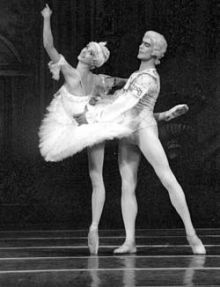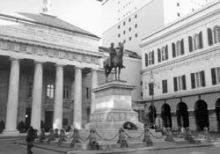The Kyivans gave seven performances of Tchaikovsky’s Sleeping Beauty on the stage of one of Italy’s most celebrated theaters — Teatro Carlo Felice, hallowed by several premieres of Verdi and Ponchielli operas and grand concerts by the brilliant Genoese virtuoso Niccolo Paganini. The news conference, organized by the theater’s administration in the prestigious Paganini Hall, was proof of the theatergoing public’s considerable interest in the guest performances by the Kyiv ballet troupe, known throughout Italy for its numerous appearances at festivals at the Arena di Verona and theaters of Macerata, Rome, Sicily, and elsewhere. This was the troupe’s first visit to Genoa.
CONCERT BILL
Since ancient times, Genoa has been a cultural center of Italy, a city-museum and city of museums, and wonderful theatrical and musical traditions. The locals know a great deal about classical art, as evidenced by the concert poster of the Carlo Felice Theater whose current season features a Mozart series dedicated to the 250th anniversary of this outstanding Austrian composer: Don Juan, The Marriage of Figaro, Cosi fan Tutte, Requiem, and a series of symphony concerts. The theater’s bill features Vivaldi’s Orlando Furioso, Donizetti’s La Favorite, Verdi’s A Masked Ball, Puccini’s Madame Butterfly, and Janacek’s Kat’a Kabanova. Among the troupes that have performed or are scheduled to perform at the Carlo Felice Theater are the opera troupes of La Scala, the Donizetti Theater (Bergamo), the Grand Theater La Fenice (Venice), Dallas Opera (USA), the Monte Carlo Ballet, and others.
The theater’s invitation to the National Opera of Ukraine’s ballet troupe is further proof of the high artistic reputation of the Kyiv choreography school and the troupe’s active presence in the international cultural space. At the same time but in a different part of the world — in Argentina and the USA — another group of the Kyiv ballet troupe gave a number of performances (The Nutcracker and Giselle), and both groups returned in early January to begin a tour of Spain and Portugal. The composition and creative potential of the National Opera of Ukraine’s ballet troupe makes it possible, without reducing the number or affecting the quality of performances on the home stage, to enrich the repertoire with new ballets (rehearsals for a new ballet Viva, Mozart have just begun) and tour extensively, thus popularizing the Kyiv ballet school internationally.
Although the Kyiv ballet troupe has been touring extensively in recent months, it embarks on every tour with a sense of great responsibility and views it as a kind of test. The troupe has to perform on a different stage, not to mention the exhausting flights and traveling. Sometimes the troupe has to perform immediately after checking in at the hotel. The ballet dancers must always be composed and have endurance: they realize that they have no understudies and will have to dance under any circumstances. The performers have grown accustomed to the hectic pace of touring and learned to cope in the most unexpected situations, such as a stage that is too small or too large, as was the case in Genoa, or a stage that is altogether unsuitable for a choreographed performance, which also happens.
The tour in Genoa was properly organized, with a nice hotel near the theater, rehearsals, morning classes, a schedule of performances that was packed but quite balanced, and the rare luxury of a day off, which the performers used to see the sights in magical and unforgettable Genoa.
A tour’s success, especially one that takes place in a single city, normally depends on the impression that the spectators derive from the first performance. The fact that the audience in the Carlo Felice Theater, which seats 2,000, was filled to capacity for the first performance did not mean that attendance would remain at this level for the remaining performances.
BEAUTY OF THE SOURCE
Tchaikovsky’s Sleeping Beauty is a special ballet. Despite long-lasting and heated debates over classical ballet, which include theoretical substantiations of attempts to update it, academic troupes like the St. Petersburg Mariinsky Theater, Moscow’s Bolshoi Theater, and the National Opera of Ukraine have succeeded in safeguarding classical ballet in all its beauty, grandeur, and academic perfection. As we can see, this leads to positive results. Not only have we preserved a series of inimitable masterpieces by the most talented choreographers of the 19th century, we have also introduced them into the contemporary cultural space. Proof of this is the increasingly greater interest in these works on the part of audiences that are fed up with choreographic modern and novelties. They delight in the beauty and perfection of classical dancing, performances dominated by humanistic ideals, whose fairytale elements convey the light of the human spirit and goodness that overcomes all evil. Graphic evidence of this is the gem of the classical ballet heritage — Tchaikovsky’s Sleeping Beauty, performed by the National Opera of Ukraine’s ballet troupe on the stage of Genoa’s Carlo Felice Theater.
The small but well-coordinated troupe of 50 performers demonstrated the brilliant traditions of classical dancing, which have been preserved and developed by the Kyiv choreography school, with the soloists and corps de ballet showing superior stage mastery. However, the success of Kyiv’s Sleeping Beauty was not simply due to the fact that this ballet is one of the most complex classical works of choreography rarely featured in the repertoires of even large troupes. It was also the result of the ballet’s artistic vision that has materialized on Ukraine’s leading ballet stage. The stage in Genoa was wonderfully designed to represent the age of Ludwig XV and complemented by the set designs of Maria Levytska and strong romantic exhilaration in the rendition of Tchaikovsky’s musical score by the National Opera of Ukraine’s chief conductor Volodymyr Kozhukhar. Pride of place was given to the exceptional mastery and inspiration of the soloists, primarily the main performers Hanna Dorosh, Maksym Chepyk, Tetiana Holiakova, and Viktor Ishchuk, who took turns performing the roles of Aurora and Prince Desire. However, a major achievement of these performances is that the Kyiv troupe has preserved the brilliant choreographic score of the great Marius Petipa, which the Kyiv performers delivered to spectators in its original beauty and perfection, uncorrupted by time, repeated variations of the last century, or countless modern stylistic and artistic trends. The Italian press singled this out as one of the most brilliant artistic highlights of our performance.
The Kyiv performers displayed brilliant and impeccable classical dancing techniques, which is somewhat unusual for Western European audiences. The performance also had the special charm that is achieved through the internal concept behind the performance, the aura of creative discovery, goodwill, and sincerity. Sleeping Beauty is a special fairytale that is common to many nations. This explains the audience’s heartfelt acceptance of this interpretation of Charles Perrault’s famous fairytale, which the talented Kyiv troupe performed using a broad range of classical dancing techniques.
Virtually every variation, adagio, entree, or complete scene was received with delight by the audience in the Carlo Felice Theater, which was packed to capacity for every performance. Aside from the dancers in the main roles — Dorosh, Holiakova, Chepyk, and Ishchuk, who displayed both a brilliant classical dance technique and their inimitable creative personas and gifts — the other dancers also distinguished themselves: Japanese ballerina Shinoba Takita (Lilac Fairy), who studied at the Kyiv Choreography School and has linked her creative career with the Kyiv ballet troupe, Khrystyna Balaban (Diamond Fairy), and the dancers in the roles of the fairytale characters Kateryna Kalchenko (Red Riding Hood), Kateryna Tarasova (Cat), Kostiantyn Pozharnytsky (Tomcat), Oleksandr Shapoval (Wolf), and Serhiy Yehorov (Prince Fortune). Oleh Tokar created a very expressive and mimetically flexible image of the wicked witch Carabosse. The corps de ballet danced in inspired unison, creating a brilliant classical entourage for this fairytale dance. The ending of every corps de ballet scene was invariably followed by thunderous applause from the delighted public, impressed by the poetic elevation of the Kyiv fairies of diamonds, generosity, care, courage, and the maidens and cavaliers.
SEVEN OUT OF NINE
Although out of nine planned performances at Carlo Felice Theater we gave only seven (Italy also has its problems and surprises, our tour coinciding with a strike by theater employees demanding higher wages), the guest performances of the National Opera of Ukraine’s ballet troupe in Genoa were very successful. We continue our wonderful mission as ambassadors of a country with marvelous cultural traditions, superior academic art genres, and richly talented people. In turn, this enhances Ukraine’s image in Europe and facilitates our integration into the global cultural and spiritual space.








